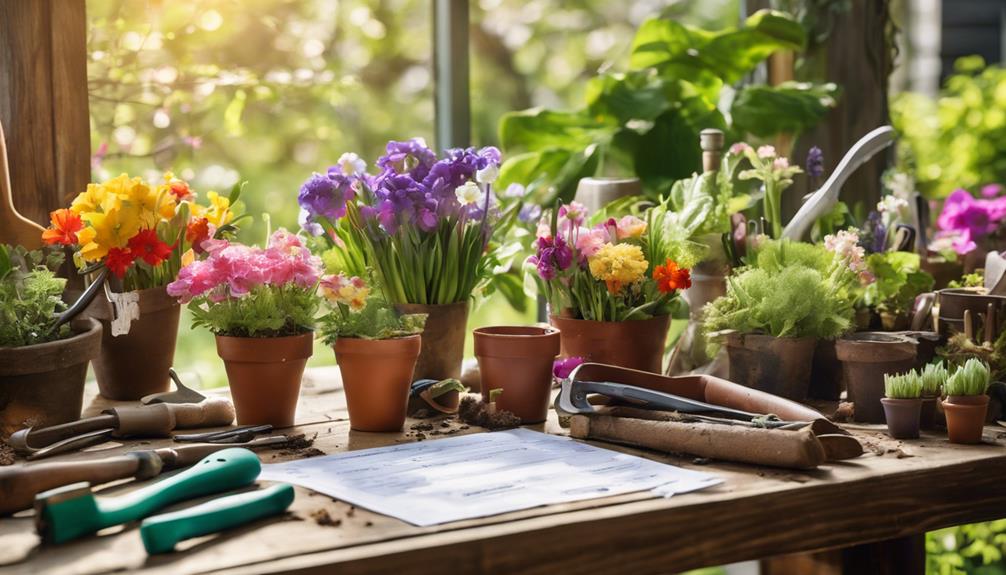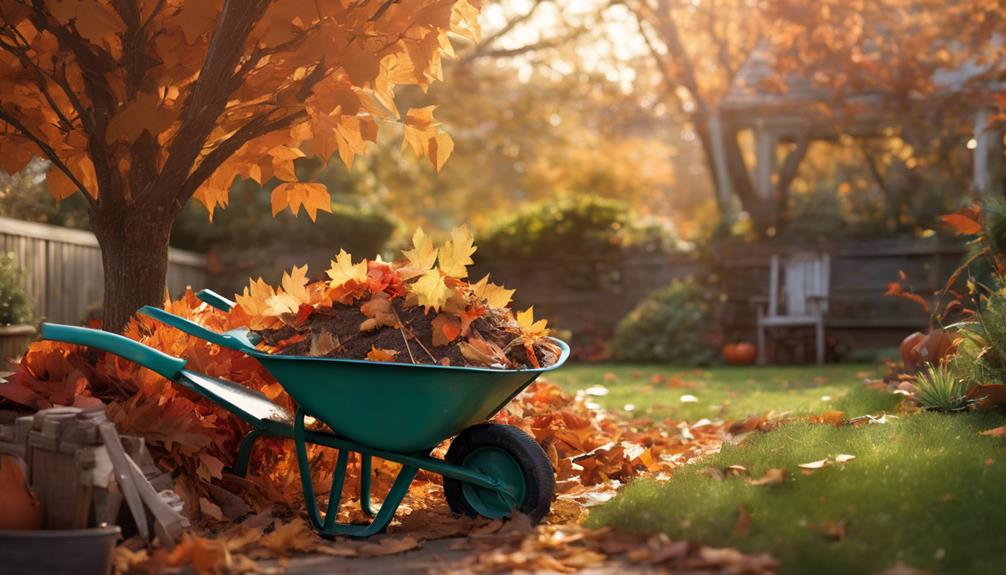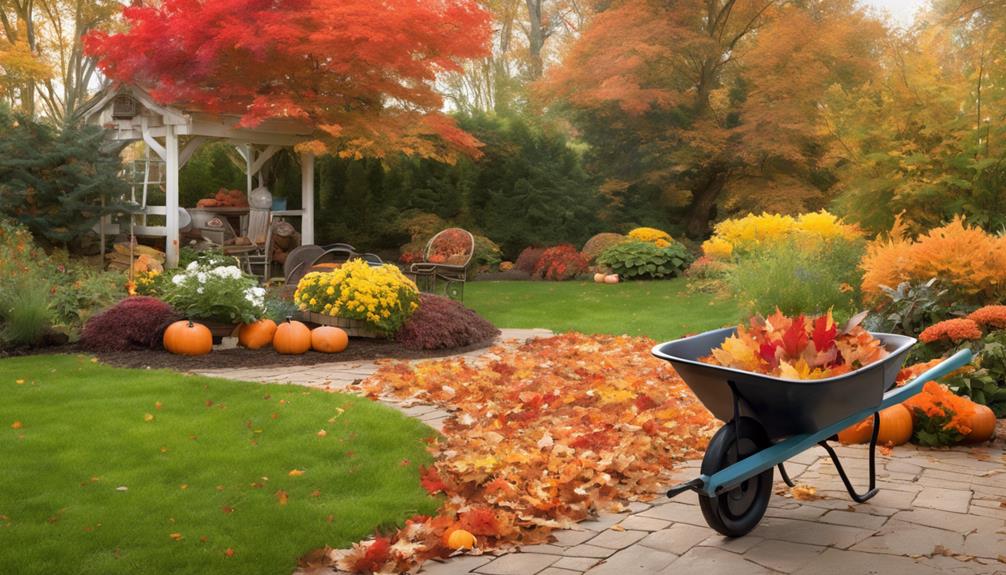
Essential Seasonal Lawn Care Tips for Homeowners
4 January 2025
5 Best Tips for Seasonal Garden Cleanup Beginners
4 January 2025A spring garden cleanup checklist is essential for revitalising your garden after the winter dormancy. It helps assess plant health, removes debris that can harbour diseases, and prepares the soil for optimal growth.
By using the right tools, such as pruning shears and a rake, you ensure effective cleanup and maintenance. Furthermore, planning tasks on a timeline enhances resource allocation, making your gardening efforts more productive.
Pest control and weed management strategies included in the checklist further support a thriving environment. Discover how a well-organised approach can set the stage for vibrant blooms and bountiful harvests.
Spring Cleaning Essentials
As spring approaches, having the right tools for effective garden cleanup is crucial for a successful start to the season.
Equally important are seasonal plant preparation tips that ensure your garden thrives.
Together, these elements form the foundation for a well-maintained and flourishing outdoor space.
Tools for Effective Cleanup
When embarking on a spring garden cleanup, having the right tools at your disposal can make all the difference.
Essential tools include a sturdy rake for gathering leaves and debris, a sharp pair of pruning shears for trimming overgrown plants, and a high-quality garden spade for digging.
A hand trowel is invaluable for smaller tasks, while a wheelbarrow facilitates the efficient transport of waste.
Furthermore, consider a garden fork to aerate soil and effectively remove weeds.
Gloves are crucial for hand protection, and a quality hose or watering can ensures your plants receive adequate hydration after the cleanup.
Investing in these important tools will streamline your efforts, enabling you to achieve a pristine garden in preparation for the growing season.
Seasonal Plant Preparation Tips
With the right tools at your disposal, attention must turn to the plants themselves to ensure they flourish throughout the growing season.
Start by assessing each plant's health; remove any dead or diseased foliage to prevent the spread of pathogens. Prune perennials to encourage vigorous growth, and divide overcrowded specimens to promote air circulation.
Consider the quality of the soil; amend it with organic matter to enhance fertility and drainage. Fertilise properly according to specific plant needs, ensuring that nutrients are available for optimal growth.
Ultimately, plan for adequate watering routines, adjusting for changes in weather. By meticulously preparing your plants for the season ahead, you establish a foundation for a thriving garden that will yield vibrant blooms and bountiful harvests.
Essential Tools Required
To effectively tackle your spring garden tidy-up, having the right tools is essential.
Pruning shears will ensure precise cuts for healthy plant maintenance, while a garden rake facilitates soil aeration and debris removal.
Furthermore, a compost bin plays an important role in managing organic waste, promoting a sustainable gardening practice.
Pruning Shears for Precise Cuts
A quality pair of pruning shears is an indispensable tool for achieving precise cuts in your garden. Their efficacy lies in their ability to shape plants, promote healthy growth, and prevent disease.
Investing in the right shears ensures that your gardening efforts yield optimal results.
Consider these key features when selecting your pruning shears:
- Blade Material: High-carbon steel blades maintain sharpness and resist corrosion.
- Ergonomic Design: Handles that fit comfortably in your hand minimise fatigue during extended use.
- Cutting Mechanism: Bypass versus anvil style; choose based on the type of plants you will prune.
With the right pruning shears, you can master the art of plant care and enhance the health and aesthetics of your garden.
Garden Rake for Soil Aeration
Maintaining a healthy garden requires more than just precise pruning; soil aeration plays a significant role in promoting robust plant growth.
A garden rake is a fundamental tool for achieving ideal soil aeration, allowing air, water, and nutrients to penetrate deeper into the ground. This process improves root development and overall plant vitality.
Consider the following benefits of using a garden rake for soil aeration:
- Improved drainage: Reduces soil compaction and allows excess water to escape.
- Augmented nutrient absorption: Facilitates the movement of vital nutrients to plant roots.
- Increased microbial activity: Promotes a thriving ecosystem that supports plant health.
Investing in a quality garden rake will enhance your gardening expertise and foster a flourishing landscape.
Compost Bin for Waste Management
While a flourishing garden thrives on healthy soil, effective waste management is equally crucial, and a compost bin serves as a fundamental tool in this process.
Utilising a compost bin not only reduces waste but also enriches your garden, creating a sustainable cycle of nutrients.
To ensure a successful composting experience, consider these key tools:
- Compost aerator: Facilitates oxygen flow, promoting decomposition.
- Thermometer: Monitors internal temperature, ensuring optimal microbial activity.
- Shovel or pitchfork: Aids in mixing and turning compost materials efficiently.
Create a Timeline for Tasks
Establishing a timeline for garden cleanup tasks is essential for efficient spring preparation.
Begin by evaluating the current condition of your garden to identify necessary actions. Following this, schedule mulching to improve moisture retention.
Additionally, consider arranging soil testing to ensure nutrient balance, which will support healthy plant growth throughout the season.
Assess Garden Condition First
Before embarking on your spring garden clean-up, it is essential to thoroughly assess the condition of your garden to identify specific needs and prioritise tasks effectively.
A meticulous evaluation will enable you to allocate resources efficiently and ensure a productive growing season.
Consider the following aspects during your assessment:
- Soil Health: Examine soil texture and nutrient levels to determine necessary amendments.
- Plant Condition: Identify which plants require pruning, replacement, or additional care.
- Pest and Disease Presence: Look for signs of infestations or diseases that may need immediate attention.
Mulch for Moisture Retention
Applying mulch is a crucial step in your spring garden cleanup, as it helps retain soil moisture, suppress weeds, and regulate soil temperature. A well-mulched garden not only enhances aesthetic appeal but also promotes healthy plant growth by creating a stable environment.
Consider these key benefits of mulching:
- Moisture retention: Reduces evaporation, keeping the soil consistently moist.
- Weed suppression: Blocks sunlight, inhibiting weed germination and growth.
- Temperature regulation: Insulates the soil, protecting roots from extreme temperatures.
To optimise these benefits, apply a layer of organic mulch, such as shredded bark or straw, around your plants after clearing debris. Aim for a thickness of 5-7.5 centimetres, ensuring the mulch remains clear of plant stems to prevent rot.
Soil Testing for Nutrient Balance
A thorough soil testing process is essential for achieving a balanced nutrient profile in your garden. Testing your soil not only informs you of existing nutrient levels but also guides your fertilisation strategy, ensuring optimal plant health.
Consider the following key steps in your soil testing timeline:
- Sample Collection: Gather samples from different garden areas for a representative analysis.
- Laboratory Analysis: Send samples to a certified laboratory to determine nutrient levels and pH balance.
- Interpreting Results: Analyse the report to identify deficiencies or excesses, enabling targeted amendments.
Improved Plant Health and Growth
Enhancing plant health and growth is a vital outcome of a thorough spring garden cleanup. This process not only removes debris that harbours diseases but also improves airflow and sunlight penetration, fundamental factors for robust growth. Proper cleanup fosters a healthier environment, allowing plants to thrive.
| Key Actions | Benefits |
|---|---|
| Remove dead vegetation | Reduces disease spread |
| Prune overgrown branches | Encourages new growth |
| Clear away weeds | Minimises competition for nutrients |
Pest Control Treatments
As spring approaches, implementing effective pest control treatments is crucial for maintaining a healthy garden.
Options such as organic pesticide spray applications, beneficial nematode treatments, and the strategic release of beneficial insects can significantly reduce pest populations while promoting ecological balance.
This proactive approach not only protects your plants but also fosters a sustainable gardening environment.
Organic Pesticide Spray Application
With the arrival of spring, garden pests can quickly become a concern for any gardener.
Implementing an organic pesticide spray application is crucial for maintaining a healthy garden ecosystem. This method not only targets harmful pests but also minimises the impact on beneficial insects.
Consider the following when applying organic pesticides:
- Timing: Apply sprays early in the morning or late in the evening to reduce evaporation and protect pollinators.
- Concentration: Follow the recommended dilution rates to ensure efficacy without harming plants.
- Coverage: Ensure thorough coverage of both the upper and lower leaf surfaces for maximum penetration.
Beneficial Nematode Treatment
Utilising beneficial nematodes as a pest control treatment offers an effective, environmentally friendly solution for managing soil-dwelling pests.
These microscopic roundworms are natural predators of various harmful insects, ensuring your garden thrives without the need for synthetic chemicals.
Consider the following benefits of incorporating beneficial nematodes into your pest management strategy:
- Targeted Action: They specifically seek out and eliminate pests such as grubs and root weevils.
- Non-Toxic: Safe for humans, pets, and beneficial insects, they promote a healthier ecosystem.
- Ease of Use: Simple application methods allow for seamless integration into existing garden care routines.
Integrating beneficial nematodes into your spring garden cleanup not only safeguards your plants but also enhances soil health and overall biodiversity.
Beneficial Insect Release Strategy
Implementing a beneficial insect release strategy is a crucial component of an effective pest control programme, especially during the spring garden cleanup. By introducing these natural allies, gardeners can improve ecosystem balance and reduce reliance on chemical treatments.
- Ladybirds: Excellent aphid predators that help manage pest populations.
- Lacewings: Their larvae consume a wide variety of soft-bodied insects, including thrips and mealybugs.
- Parasitic Wasps: Target specific pests like caterpillars and aphids, effectively controlling their numbers without harming beneficial species.
To optimise the success of this strategy, carefully evaluate your garden's specific pest challenges, timing of release, and environmental conditions.
Weeds and Their Management
Effective weed management is crucial for maintaining a healthy garden.
Techniques such as mulching can significantly suppress weed growth, while proper aeration of compacted soil enhances root development and overall plant vigour.
Furthermore, the application of natural herbicides offers an environmentally friendly approach to controlling unwanted vegetation.
Mulching to Suppress Weeds
A gardener's best ally in the battle against weeds is mulch, a natural barrier that not only suppresses unwanted growth but also improves soil health.
By creating a protective layer, mulch effectively inhibits light penetration, which is crucial for weed seed germination. Furthermore, it retains moisture and regulates soil temperature, fostering an ideal environment for desirable plants.
Consider the following benefits of mulching:
- Weed suppression: Reduces the germination of weed seeds by blocking sunlight.
- Moisture retention: Minimises evaporation, ensuring that the soil remains adequately hydrated.
- Soil enrichment: As organic mulches decompose, they improve soil structure and nutrient content.
Incorporating mulch into your gardening strategy is a vital practice for achieving a thriving, weed-free landscape.
Compacted Soil Aeration Techniques
Soil compaction can severely hinder plant growth and promote weed proliferation by restricting root development and reducing water infiltration.
To combat these issues and improve soil health, employing effective aeration techniques is crucial. Consider the following methods:
- Core Aeration: Utilising a machine to remove soil cores allows for improved air and water movement within the soil.
- Spike Aeration: This technique involves puncturing the soil with spikes, creating channels for air and moisture while minimally disturbing the turf.
- Vertical Mowing: Also known as dethatching, this method removes excess thatch and promotes deeper root growth, further alleviating compaction.
Incorporating these aeration techniques will not only rejuvenate your garden but also inhibit weed establishment, fostering a healthier ecosystem for your plants.
Natural Herbicide Application
Weeds can significantly undermine the health and productivity of a garden, particularly in areas where soil compaction has been addressed.
Implementing natural herbicide applications can effectively manage these invasive plants while preserving ecological balance.
Consider the following strategies:
- Vinegar Solutions: Use acetic acid to target weeds selectively.
- Boiling Water: A simple yet effective method to eliminate weeds on contact.
- Mulching: Organic materials can suppress weed growth while enriching the soil.
Utilising these techniques not only minimises chemical exposure but also fosters a healthier garden ecosystem.
Mastering natural herbicide applications enhances your gardening practices, promoting sustainable weed management while allowing the desired flora to thrive.
Prioritise these methods in your spring garden cleanup checklist for optimal results.
Why Choose TKL Birmingham Gardener
When considering your spring garden clean-up, partnering with TKL Birmingham Gardener can significantly enhance the efficiency and effectiveness of your efforts.
Their team of experienced professionals brings a wealth of knowledge in horticulture and landscape management, ensuring that your garden receives personalised care.
TKL employs sustainable practices, harnessing eco-friendly techniques to rejuvenate your outdoor space responsibly.
By utilising advanced tools and methodologies, they can efficiently tackle complex clean-up tasks, allowing you to focus on your gardening aspirations.
Furthermore, their commitment to customer satisfaction guarantees that every detail is meticulously attended to.
With TKL Birmingham Gardener, not only do you achieve a pristine garden, but you also cultivate a lasting partnership rooted in expertise and a shared passion for horticultural excellence.
Common Gardening Questions Answered
Engaging with a professional gardening service like TKL Birmingham Gardener can provide a wealth of knowledge, helping gardeners to better understand and navigate common challenges.
One prevalent question pertains to soil health; testing pH levels is essential to ensure optimal nutrient availability.
Moreover, many gardeners ask about the best time to prune. Generally, late winter or early spring is ideal for most shrubs, promoting vigorous growth.
Pest management is another concern; integrating companion planting can naturally deter harmful insects.
Finally, understanding the importance of crop rotation helps maintain soil health and prevent disease.
Plan for Seasonal Planting
As spring unfolds, it presents an ideal opportunity for gardeners to strategise their seasonal planting.
To optimise your garden's potential, consider the following key elements:
- Soil Preparation: Ensure optimal soil health through testing and amendment.
- Crop Rotation: Implement thoughtful rotation to improve soil nutrients and reduce pests.
- Plant Selection: Choose varieties suited to your climate and growing conditions.




